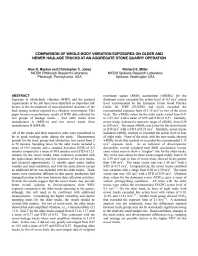Mining Publication: Comparison of Whole-Body Vibration Exposures on Older and Newer Haulage Trucks at an Aggregate Stone Quarry Operation
Original creation date: August 2008
Exposure to whole-body vibration (WBV) and the postural requirements of the job have been identified as important risk factors in the development of musculoskeletal disorders of the back among workers exposed to a vibratory environment. This paper focuses on preliminary results of WBV data collected for two groups of haulage trucks - four older trucks from manufacturer A (MFR-A) and two newer trucks from manufacturer B (MFR-B). All of the trucks and their respective seats were considered to be in good working order during the study. Measurement periods for the truck groups had similarities, but varied from 2 to 58 minutes. Sampling times for the older trucks included a mean of 19.5 minutes and a standard deviation (STD) of 6.5 minutes compared to a mean of 40.8 minutes and a STD of 12.1 minutes for the newer trucks. Data collection coincided with the approximate delivery and first operation of the new trucks, and occurred approximately 12 months apart under similar weather and road conditions, and with the same drivers except an additional driver was included with the older trucks. Truck routes were somewhat different in that quarry production had changed location in the time between data collection activities. Overall, the results suggest that the newer trucks may provide better overall isolation to drivers/operators from WBV exposure compared to the older trucks operating at the quarry; although, this will need to be confirmed with additional measurements. Considering the higher variability and shorter sampling times for the older trucks, the results should be viewed with caution. For two of seven trials, the older trucks showed that seats amplified vibration, i.e., a transmissibility (T) >1.0. Seat T for the older trucks ranged from 0.31 to 1.17 with a mean of 0.77 and STD of 0.32. This contrasted with the newer haulage trucks where seats amplified vibration in 3 of 8 trials. In this case, T did not vary greatly and ranged from 0.87 to 1.05 with a mean of 0.97 and STD of 0.07. Regarding older trucks, in five of seven trials, the seat (output) data of weighted root-mean square (RMS) acceleration (wRMSz) for the dominant z-axis exceeded the action level of 0.5 m/s2 action level recommended by the European Union Good Practice Guide for WBV (EUGPG) and levels exceeded the recommended exposure limit of 1.15 m/s2 in two of the seven trials. The wRMSsub>z) values for the older trucks varied from 0.41 to 1.83 m/s2 with a mean of 0.99 and STD of 0.57. Similarly, newer trucks indicated a narrower range of wRMSZ from 0.38 to 0.95 m/s2. The mean wRMSZ was lower for the newer trucks at 0.58 m/s2 with a STD of 0.23 m/s2. Similarly, newer trucks indicated wRMSsub>z) reached or exceeded the action level in four of eight trials. None of the trials with the new trucks showed wRMSsub>z) levels that reached or exceeded the recommended 1.15 m/s2 exposure limit. As an indicator of driver/operator discomfort, overall weighted total RMS acceleration (vector sum) values seem to show a “rougher” ride for the older trucks. The vector sum values for these trucks ranged widely from 0.70 to 2.59 m/s2 and, in four of seven trials, showed levels greater than 1.40 m/s2. The mean vector sum was 1.44 m/s2 with a STD of 0.75 m/s2. Comparatively, the newer trucks exhibited less variation with a range from 0.69 to 1.59 m/s2. The mean vector sum was 1.02 m/s2 with a STD of 0.35 m/s2. Vibration dose values for the dominant z-axis (VDVsub>z)), gave a sense of vehicle jarring/jolting conditions. All trials with the older trucks were within the recommended EUGPG action level of 9.1 m/1.75. On the other hand, in three of eight trials, both newer trucks exceeded this action level with values of 9.18, 12.58, and 13.21 m/s1.75. Neither truck group showed VDVsub>z) that exceeded the exposure limit of 21 m/s1.75. A statistical analysis was not conducted, since the differences reported between truck groups may not be statistically significant owing to the relatively small sample size. Road conditions, changes in the truck routes, and driver/operator differences (e.g., stopping and turning) are possible factors in the higher VDV for the newer trucks.
Authors: AG Mayton, CC Jobes, RE Miller
Conference Paper - August 2008
NIOSHTIC2 Number: 20034733
ME 2008 International Design Engineering Technical Conferences & Computers and Information in Engineering Conference, (IDETC/CIE 2008), August 3-6, 2008, Brooklyn, New York. DETC2008-50120, New York: American Society of Mechanical Engineers, 2008 Aug; :1-7
See Also
- Acceleration and GPS Data Monitor Truck-Haulage Jolts
- Assessment of Whole-body Vibration Exposures and Influencing Factors for Quarry Haul Truck Drivers and Loader Operators
- Characteristics of Fugitive Dust Generated from Unpaved Mine Haulage Roads
- Engineered Solutions - Dump Truck Vibrations and Impact on Operator Safety in High-Impact Shovel Loading Operations
- Laboratory Investigation of Seat Suspension Design Performance during Vibration Testing
- Physiological Responses and Subjective Discomfort of Simulated Whole-Body Vibration From a Mobile Underground Mining Machine
- Technology News 516 - ARMPS-HWM: New Software for Sizing Pillars for Highwall Mining
- Test Results of Collision Warning Systems for Surface Mining Dump Trucks
- Tying Acceleration and GPS Location Information Together To Create a Mine Management Tool
- Whole-Body Vibration Exposure Comparison of Seat Designs for Low- and Mid-Seam Shuttle Cars in Underground Coal Mines
- Page last reviewed: 9/21/2012
- Page last updated: 9/21/2012
- Content source: National Institute for Occupational Safety and Health, Mining Program


 ShareCompartir
ShareCompartir
